Introduction
Karnataka’s foray into the textile sector has turned out to be quite a successful venture. So much so that Bangalore has earned itself the moniker of the ‘garment capital of India’. With the textile industry occupying a key position in the economy of Karnataka, the state government is working towards leveraging the potential for growth of the textile sector in the state. Let us know in detail about the textile industry of Karnataka and its prospects for growth.
ART AND CULTURE OF KARNATAKA

Karnataka has a rich Cultural heritage. The lineages of Indian rulers, like, Mauryas, Chalukyas, Hoysalas have left behind their embossments in various elements of culture of Karnataka. Diverse religion and languages has added up to the ethnic grandness. Apart from Kannadigas, Karnataka is home to Tuluvas, Kodavas and Konkanis. Minor populations of Tibetan Buddhists and Siddhi tribes plus a few other ethnic groups also live in Karnataka. Karnataka’s art forms encompass huge ambit of majestic festivals, music, drama, and royal cuisine. The vivid diversity exists in cultural aspects in terms of Cultural dress, traditional dance forms, social and cultural history, culture food, language and slangs. The traditional folk arts cover the entire gamut of music, dance, drama, storytelling by itinerant troupes, etc. Yakshagana, a classical folk play, is one of the major theatrical forms of coastal Karnataka. Contemporary theatre culture in Karnataka is one of the most vibrant in India with organizations like Ninasam, Ranga Shankara and Rangayana active on foundations laid down by the Gubbi Veeranna Nataka Company. Veeragase, Kamsale and Dollu Kunitha are popular dance forms. Bharatanatya also enjoys wide patronage in Karnataka.
Festivals of Karnataka
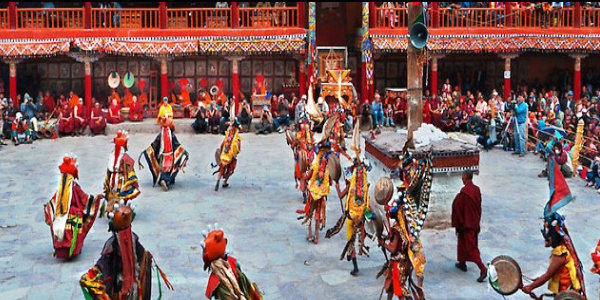
The popular
festivals of Karnataka are Hampi Festival (Vijay Utsav), Tula Sankramana Coorg
Festival, Vairamudi Festival, Hoysala Mahotsava and Hoysala Mahotsava.
Karnataka Rajyotsava:Kannada Rajyotsava (Karnataka Formation Day) is
celebrated on 1 November of every year. This was the day in 1956 when all the
Kannada language-speaking regions of South India were merged to form the state
of Karnataka. The Rajyotsava day is listed as a government holiday in the state
of Karnataka and is celebrated by Kannadigas across the world. It is marked by
the announcement and presentation of the honours list for Rajyotsava Awards by
the Government of Karnataka, hoisting of the unofficial Karnataka flag with an
address from the Chief Minister and Governor of the state along with community
festivals, orchestra, Kannada book releases and concerts.
Rajyotsava day is celebrated with great joy and vigour all over the state of
Karnataka. The entire state wears a festive look on this day as the red and
yellow Kannada flags are hoisted at different strategic locations across the
state and the Kannada anthem (“Jaya Bharatha Jananiya Tanujate”) is
chanted. The flag is hoisted at political party offices and several localities
even as youth in many areas take out processions on two-wheelers. Religion not
being a factor, the Rajyotsava is celebrated by Hindus, Muslims and Christians
as well.
Hampi Festival: Hampi Festival is celebrated reminiscing the aura
of Vijaygarha kings, in winter month of November. You can also see festivals of
similar type in regions of Halebid, Pattadakal, Karavalli and Lakkundi, during
the season.
Tula Sankramana Coorg Festival: It is a festival of joy
commemorating the worship of Goddess Cauvery. Also known as theerthodbhava and
is celebrated in the month of October with enthusiasm especially in Kodagu of
Karnataka region. Believing that the Goddess will emerge from water , the ‘bhaktas’
from all over the world gather in huge number, take dip into the holy water of
the Cauvery water and seek blessings from the deity. Pattadakkal Dance Festival
This is a festival of dance celebrated in jubilance at the premises of
beautiful temples of Pattadakkal, the ancient capital of the Chalukyan kings.
It is feted in the month of January. Moreover, other festivals like Holi, Makar
Sankranti, Dusshera, Diwali are celebrated in full frolic and vivacity, just
like any other state of Indian subcontinent.
Vairamudi Festival: In Melkote, this festival is feted in the month
of March when the idol Lord Vishnu is being decked up with precious crown
studded with diamond brought out from the palace of Mysore.
Kambala or Buffalo Race: This festival of buffalo racing was
celebrated with lots of exuberance by the royal kings and the people of the
Karnataka keep up this tradition of royal sport.
Hoysala Mahotsava: This magnificent festival of dance takes place
in places like Belur and Helebid .The fantabulous Hoysala temples are perfect
embodiment of exquisite work of sculptures, thus making it the perfect locale
for this cultural fete. It is famous in the month of March.
Music

Both Carnatic Music and Hindustani music proliferated in this region. Karnataka is a unique place where both Hindustani and Carnatic singers flourish. North Karnataka is predominantly famous for Hindustani music and South Karnataka is well known for Carnatic music.
Carnatic music: With the rise of Vaishnavism and the Haridasa movement came Karnataka composers like Purandaradasa, whose Kannada language works were lucid, devotional and philosophical and hence appealing to the masses. Other haridasas of medieval times were Kanakadasa, Vyasatirtha, Jayatirtha, Sripadaraya, Vadirajatirtha etc., who composed several devara nama. One of the earliest and prominent composers in South India was the saint, and wandering bard of yore Purandara Dasa. Though historians claim Purandara Dasa composed 75,000 – 475,000 songs in Sanskrit and Kannada, only a few hundred of them are known today. He was a source of inspiration to the later composers like Tyagaraja. Owing to his contribution to the Carnatic Music he is referred to as the Father of Carnatic Music (Karnataka Sangeeta Pitamaha) Purandaradasa codified and consolidated the teaching of Carnatic music by evolving several steps like sarali, jantai, thattu varisai, alankara and geetham and laid down a framework for imparting formal training in this art form. Later in the 17th and 18th centuries, the haridasa movement would once again contribute to music in Karnataka in the form of haridasas such as Vijaya Dasa, Gopaladasa, Jagannathadasa who are just a few among a vast galaxy of devotional saints.
Dance Art Forms in Karnataka
Beesu Kamsale, Dollu Kunita, Goravara Kunita, Kamsale, Kolaata, Paata Kunita, Puravanthike, Kangilu Kunita, Bolukat, Dappu Kunita, Suggi Kunita, Ummathat, Chitmela and Gumatepong are the popular Dance and Art Forms in Karnataka. Yakshagana a form of dance drama is one of the major theatrical forms in coastal Karnataka. A fusion of folk and classical tradition makes Yakshagana a unique form of art which includes colourfull costumes, music, dance, singing, and most importantly dialogs composed on the fly. Award winning performers include Shambhu Hegde, Chittani Ramachandra Hegde. Yakshagana and Dollu Kunitha are two of the popular dance forms of Karnataka. Gamaka is a unique music form based on Karnakata Sangeetha. ‘Boodkali’ of Coorg, ‘Daasaraata’ of North Karnataka etc seems to have lost its value in time. Various dance forms namely Veeragase and Kamsale etc ennoble the culture of Karnataka. Dollu Kunitha is a special dance form practiced by male shepherds of Kuruba community with the accompaniment of coloured drums. Devare Thatte Kunitha, Yellammana Kunitha, Suggi Kunitha and others have derived their names from the deity or the symbol or instruments that are used. Karnataka patronizes Bharatanatyam, the illustrious dance style of South India. Other mainstream classical dances here include Kuchipudi and Kathak.
‘Silappadikaram’, the Tamil text, refers to a dance of the Kannadigas performed in the court of Chera king Senguttavan. An inscription in Pattadakal reveals that Devadasis were engaged in ‘Nritya seva’ in temples. Gangas, Rashtrakuta and the later Chalukyas were patrons of Dance. Bhandary Lakshminarayana, the Natyacharya in Krishnadevaraya’s court, was called ‘Abhinava Bharata’. Dancers were encouraged to perform during the annual Dasara celebrations by the Vijayanagar rulers. The Mysore court also encouraged traditional dance, following the footsteps of the Vijayanagar rulers.

Painting
The Bengal renaissance influenced the Mysore school of painting. King Krishnaraja Wodeyar III patronised famous painters including Sundarayya, Tanjavur Kondayya and Alasinrayya. King Krishnaraja Wodeyar IV patronised B. Venkatappa, Keshavayya, Nagaraju, Paavanje and Kamadolli. The Chamarajendra Technological Institute, Jaganmohan Art Gallery and Venkatappa Art Gallery are reminders of this heyday. Chitrakala Parishat is an organisation in Karnataka dedicated to promote painting, mainly the Mysore painting style.

Cuisine of Karnataka
The rich heritage of culture of Karnataka makes an ideal tourist spot. Karnataka’s richness in culture and tradition, epitomizing through the wondrous monuments, has mesmerized every one from teens to oldies.

TRIBE OF KARNATAKA

Members of the Adiyan tribe live mostly in Mysore and districts bordering Kerala and speak Kannada. They are only 758 in number and are mostly agricultural labourers. They remain poor and have a low literacy rate. Marriages among cousins are common. There are a few members (266) of the Barda tribe of Gujarat and Maharashtra found in the State, mostly in the northern districts. They speak Barda language which is similar to Marathi and Gujarati. They are agricultural labourers, and are mostly endogamous. The Bavacha/Bamcha are Hindu tribes who speak the Bavchi dialect3. They are 960 in number and are mostly inhabitants of Ramanagar district.

Bhils are adivasis of Central Indian origin. The Bhil tribes are divided into a number of endogamous territorial divisions, which in turn have a number of clans and lineages. Most Bhils now speak the language of the region they reside in. Originally hunters and soldiers, they are mostly agricultural workers with hunting and gathering remaining a significant subsidiary occupation3,4. The Bhil population in Karnataka is 6,204 and are scattered in most districts of the State, more so in Uttara Kannada and Belgaum districts.
The Chenchus are an aboriginal tribe who speak the Chenchu or Chenchwar language, a branch of Telugu, and live mostly in the forests of Andhra Pradesh. About 954 of them inhabit bordering districts of Karnataka like Yadgir and Kolar. The Chenchus are one of the original primitive tribal groups that are still dependent on forests and do not cultivate land but hunt for a living. Some however, live symbiotically with non-tribal communities and many collect forest products for sale to non-tribal people. The Chodharas are a group of about 117 people living in Karnataka among the 20,000 odd members most of whom inhabit Gujarat and Maharashtra. They are related to the Rajputs and speak Chodri. Most of the Chodhari people work as small farmers growing cotton, vegetables, and rice.
The Dublas, some of whom are also called Talavia or Halpati, are Hindu tribes originating from the Rajputs in Gujarat and Maharashtra. Dubla society consists of several endogamous sub-divisions with agriculture as primary occupation4. They are also very few in number (264) and are mostly scattered in distribution over the State. The Gamit tribe (also known as Gamit, Gavit, Mavchi and Pandvi) people speak in Gamit. They are about 516 of them who are now inhabitants of Karnataka, mostly found in Koppal and scattered over several other districts. The Gond tribe is the largest of Dravidian people of central India, spread over various States including the North-Western districts of Karnataka (Fig. 2). They are the second largest tribal group found in the State. Gondi language is related to Telugu and other Dravidian languages. Gowdalu are 8,617 in number according to the 2011 Census data2, and speak Gowdalu language. They are mostly found in Chikmangalur and Bengaluru Urban districts in the State. The Hakki-Pikki clan is a semi-nomadic group and they live near Bidadi in Karnataka. Their population in the State is 11,892 as per 2011 Census2. The tribe has taken up hunting as their occupation but many are now showing more interest in agriculture and floral decoration. The Hasalaru are Hindu tribes of Karnataka. They are 24,466 in number and speak Tulu and concentrated in several districts including Chikkamangaluru, Shimoga, Udupi, and Davangere. In Karnataka, people belonging to Irular tribe are about 700 in number. They are more conspicuous in the Nilgiri Hills of neighbouring Tamil Nadu and Kerala and are listed under the Primitive Tribe Group. They are Hindus and speak Irula which is related to the Dravidian languages Tamil and Kannada. These people are descendants of gypsies living in caves with hunting and gathering as their ancestral occupation. They subsequently learnt the art of cultivation. People from the same clan within the Irular tribe do not intermarry. Their literacy rate is very low at 36.27 per cent5. The Iruliga are also primarily tribes of Karnataka with a total population of about 10,259, mostly living in Ramanagar and Bengaluru Urban districts. They are Hindus and while Kannada is their principal language, a few other languages are also spoken.
EMBROIDERY OF KARNATAKA

Kasuti embroidery is a special craft practiced mainly in Uttara Kanara district or the North Kanara district. Its secret lies in the fact that it can be done only by counting the threads of the weft and the warp. There is no possibility of tracing or implanting the design prematurely as outlines. The women of Karnataka turned for design to their own surroundings and chose the ones that appealed to their religious, artistic or domestic instincts.
The religious motifs are the Gopurams of temples, the chariot and palanquin in which the deity is carried on ceremonial occasions, the lotus, the tuisi katti which is the enclosure for the sacred tulsi plant. Elephants with howdahs, peacocks with spread plumage, birds of different kinds, animals and flowers are standard motifs. The cradle, anklet-bells, palanquins and other articles of everyday use are artistically depicted. The material on which the embroidery is executed is a hand woven cloth of dark colour, usually black.
The sarees, known as Ilkal sarees, have a wide silk pallu and border, the main fabric being thick soft cotton. The largest and most closely spaced motifs are placed near the pallu. As the embroiderer moves towards the main part of the saree the motifs become smaller and more scattered until they fade away gracefully with clusters of stars or mere dots.

The most frequently used colors are red, purple, green, orange and crimson. Patterns in only one or two colors are extremely rare and the usual colour combinations are orange, green and crimson or purple, green, orange and red, the brighter shades of these being preferred. The Kasuti embroidery is done in silk which, earlier, was unpicked from the tassels pendant from the pallu. Later it came to be obtained commercially. The basic embroidery stitches used in Kasuti work are the back stitch, running stitch, cross stitch and zig-zag running stitch. In certain work the overall effect is of a woven design rather than of embroidery. Kasuti stitches are horizontal, vertical or diagonal. These are used going in one direction, the design being completed on the return journey by filling in the blank portions in the running stitch.
With considerable dexterity, an ordinary sewing needle is used to create a variety of designs with coloured threads on the cloth. The embroidery is done only by women. The two kinds of stitching are Gavanti (line or double running stitch) and Murgi (zig-zag lines done with a darning stitch). The two sides are neat and identical. Negi is the ordinary running stitch used in large designs, creating a woven design effect. Menthi is a cross-stitch used for architectural patterns. Vertical, horizontal, and diagonal stitches are used. The motifs have to be completed as the stitching line comes back to fill in the blank spaces.
Kasuti embroidery is believed to have originated from north Karnataka which spread all over the region. There are literary references which date back to 15th century. Every woman was expected to adorn her sari and blouse with Kasuti embroidery. The history of Kasuti dates back to the Chalukya period. The name Kasuti is derived from the words Kai (meaning hand) and Suti (meaning cotton), indicating an activity that is done using cotton and hands. The women courtiers in the Mysore Kingdom in the 17th century were expected to be adept in 64 arts, with Kasuti being one of them. The Kasuti embroidery features folk designs influenced by rangoli patterns of Karnataka. Mirror work embroidery and gold and silver thread embroidery were mostly used for special occasions like weddings. Sarees embroidered with Kasuti were expected to be a part of the bridal trousseau of which one saree made of black silk with Kasuti embroidery called Chandrakali saree was of premier importance.
TEXTILES OF KARNATAKA
The Karnataka Cotton Saree
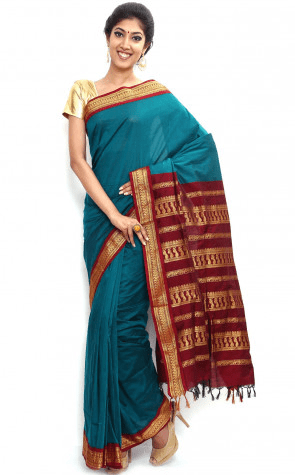
This is one of the most comfortable sarees of all time. The cotton used in making this saree is totally authentic and will provide you with utmost comfort. If you are looking for some of the best designer materials (in sarees), then this particular one will be of real help to you. The pattern done in this saree is very cool and it sports the latest pattern on the edges and you will be able to sport with utmost pride and confidence, knowing that you are wearing something totally authentic.
2. The Karnataka Bengaluru Saree:

The saree pattern is quite famous in that city. The patterns done on the saree body and on the edges are the prime attraction of this design and you will totally fall in love with the color pattern this saree sports. If you are looking for something trendy and totally worth the money, then this will be a good one for you.
3. The Maroon Cotton Karnataka Saree:
This is basically a maroon saree, which comes with a yellow pattern done on it. The way the color yellow has been used in designing this saree is very alluring an that can be said to be one of the prime attractive facts about this saree. This saree comes with a rust colored border and stripes that makes it very attractive. The pallu comes with horizontal and vertical stripes forming checks like patterns.
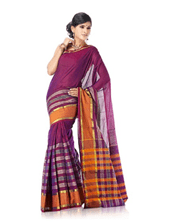
4. The Traditional Karnataka Saree
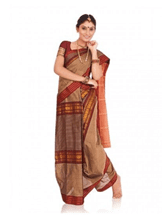
This particular traditional Karnataka saree will be most suitable for festive occasions. The design done on it looks so awesome that you will totally fall in love with it. If you are looking for some really cool designs in the Karnataka-made sarees, then this can be said to be most suitable according to your preference.
5. The Karnataka Handloom Saree:

This is one of the finest-looking Karnataka sarees of time. It sports a very attractive colorful pattern almost throughout the body of this saree which makes it look attractive in the first place. The multi colored checks all over the body with mango butis makes it look apt for traditional occasions. The pallu is quite rich with intricate motifs woven on it.
6. The Colorful Karnataka Saree:

This is one of the finest-looking Karnataka sarees of time. It sports a very attractive colorful pattern almost throughout the body of this saree which makes it look attractive in the first place. The multi colored checks all over the body with mango butis makes it look apt for traditional occasions. The pallu is quite rich with intricate motifs woven on it.
7. The Orange Karnataka Saree:

This is probably one of the finest-looking Karnataka sarees of all time. It is totally suitable for almost all women out there and it can be easily sported almost at all events. This saree is quite light weight and easy to wear. The peacock motifs with small floral butis make it an aesthetic looking saree. Pair it with a contrast blouse to look stunning.
8. The Meghdoot Orange Karnataka Saree:
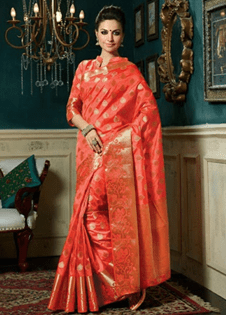
Here comes one of the best orange colored Karnataka saree. It is one of the most beautiful festive sarees. The bright orange hue with golden butis all over it makes it look regal and elegant. This saree is perfect for brides who like to stand out from the crowd and glow in their best day. The highlight of the saree is the rich zari border with beautiful floral motifs.
9. The Fancy Cotton Karnataka Saree:
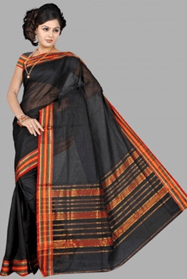
If you want to try something simple, yet elegant, this black saree is the perfect choice. The breezy cotton saree can suit almost everyone and the best part of the saree is its border. The bright red and orange border with hints of golden zari makes this saree one of the most popular picks. The saree is best worn for simple occassions and everyday wear.
10. Karnataka Silk Sarees:

This bright yellow Karnataka Silk saree is a must buy during your visit. The contrast blue border with golden zari makes it one of the most beautiful and elegant looking sarees. The highlight of this saree however is the pallu that uses a rich golden weave with blue floral weaving. Pair it with a blue blouse to create a perfect look.
11. Karnataka Mysore Silk Sarees:
This gorgeous Mysore silk saree comes in the most popular traditional combination of maroon and green. This is made with fine silk and is extremely light weight. The pure golden zari stripe runs across the border and elevates the look of the saree. You can match it with an embroidered blouse to make it suitable for grand occassions.

12. Karnataka Wedding Sarees:
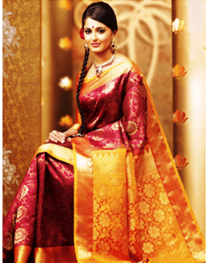
If you are looking for a heavy wedding Karnataka saree, this is a must pick. It comes in the stunning, evergreen combination of maroon and mustard. The saree has intricated floral motifs all over it and the pallu is extremely well done with big, bright flowers in self weave. The saree comes with a golden zari border and is perfect for every bride.
Karnataka sarees are usually very light weight and simple sarees. Unlike their neigbours like the Andhra Uppada or the Tamil Kanjeevaram sarees, Karnataka Silk sarees are not too heavy in weight and workmanship. They are usually available in traditooanlcolors like green. Maroon, mustard, gold, yellow etc. Karnataka sarees are easy to maintain and versatile to mix and match them with different types of blouses. They are often bought as souvenirs by tourists during their visit to this picturesque state.
COSTUMES OF KARNATAKA
The traditional dresses of Karnataka show the harmony of modernity and culture of the people living in this South-Indian State. Today’s contemporary society is influenced by the dressing and unique style of wearing dresses of the inhabitants of Karnataka. Women prefer to wear sarees. Most of the elderly men follow strict dress code to keep their traditional clothing alive as they too religious, emotional and closely connected to their culture.
Costumes of Women in Karnataka
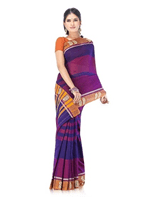
The traditional clothing for women in Karnataka is saree. It is made of silk and silk sarees are very famous not only in Karnataka but the entire country. Even Karnataka is known as a silk hub of India. A wide range of silks can be found in this place to choose from and design beautiful dresses. Many fashion designers visit Karnataka specially to buy high-quality silks for their designer and traditional clothing.
Some of verities of silks that can be found there include gorgeous brocades, sleek chiffons and smooth silks. Such saris not only beautify women of Karnataka but also help them get fame in the country and all across the globe. Mysore and Bangalore are the main epicenters of most silk industries in India. These places are known for their excellent quality and superior designs.
Kanchipuram or Kanjeevaram silks of Karnataka astonish with vivid colors, fabulous designs and rich texture. Most of the Kanchipuram Silk sarees are hand-woven made. The silk yarn is colored (dyed) to give an appropriate color and then Jari is crafted into the yarn. Pure Jari is designed with pure silk thread and knotted with a thin and designer silver wire and gilded with a pure gold. Jari is used to add a part of the shimmer in yarn. The method of Kanchipuram sarees is commonly useful for the bridal dress.
Among other prominent products, Mysore silk is one of the nice collections. The wonderful mantle, rich silk and lustrous zari make these sarees different than others. Moreover, they are low-priced than Kanchipuram silks. Thus, they are an affordable choice for ordinary people who love to buy them in bulks.
Costumes of Men in Karnataka
The traditional dress for men is Lungi. It is worn under the waist below a shirt. To cover the shoulder men take over Angavastram. During festive seasons or special occasions, men wear Panche which looks like a Dhoti. Mysore Peta is a conventional headdress for men.
Panche or Dhoti
‘Panche’, another name for Dhoti, is a rectangular piece of cloth of 4.5m metres long. This non-stitched cloth is wrapped around the legs and knotted around the waist. Panche is aesthetically worn by the men of Karnataka. This attire showcases an ethnic blend of tradition and modernity. Karnataka men pair their panches with a shirt to various occasions. In India, dhoti is predominant in the states of Tamil Nadu, Kerala, Andhra Pradesh, Maharashtra, Karnataka, Bihar, Madhya Pradesh, Assam, West Bengal, Odissa, Konkan and Goa.

Origin and History
The origin of Panche sketches out its existence and emergence centuries aback, wherein temple priests of Karnataka patronized this attire especially while conducting religious and ritualistic pujas and occasions. The traditional colors which were linked to this traditional attire were either of pure white or saffron. It was also witnessed that the great Mahatma Gandhi wore this outfit on different public occasions even when he traveled abroad. It was also worn by the devotees and priests of the ‘Hare Krishna’ sect, and gradually went onto the commoners, as this attire became a fashion trend in South India.
Traditional Costumes of Coorg or Kodagu For Men and Women
Kodagu is a district in the Karnataka which is also called as Coorg. Its traditional outfits are unique and simply look attractive. Wearing the stylish clothing is something that can give you the ultimate pleasure. You can simply browse through the details of several Coorg dresses and make a right selection. In case you are looking for Kodagu clothing online, you can find many ecommerce companies, retailers, wholesalers and other market players.
Coorg Clothing for Women
Beautiful Coorgi saree is popular for its exclusive draping pattern. The saree pleats and pallu are designed in such a way that they match perfectly while wearing. Lehenga choli, suit salwar and other Indian traditional clothes for women are also common in this part of the country.

Coorg Clothing for Men
The traditional clothing for men in Coorg includes dhoti kurta, pajama, turban (pagari), sherwani, etc. Westernization has also impacted the life of individuals and given lots of scope to them to come up with the unique collections.

ACCESSORIES OF KARNATAKA

striking piece of jewellery worn in Karnataka is called the tulunad, which is a cast-brass two-part belt, having its top edged with cobra heads with long-drawn-out hoods and has a cobra clutch at front. Jewellery of Karnataka is infused with religious connotations. A cast-brass finger ring is worn by Shiva Lingayat devotees depicting God Shiva’s vehicle, the bull Nandini, who wears an amulet containing a lingam. Female Lingayat Virashiva or lay persons (linga banajiga) wear silver lingam caskets or ayigalu, shaped in the form of an abstracted egg.
The silver lingam caskets or Gundgurdgi lingam caskets are worn on the left arm or by a Lingayat Jangam priest under a cloth cap on the head. These are often pot shaped and each contains a movable jangama or lingam. Lingayat women wear a gold fertility necklace for obtaining male offspring that consists of thirty pendants set in gold, each with a symbolic meaning connected with fertility. Gemstone like black and red coral are set onto the chain.. For the worship of Lord Shiva and Goddess Parvati, the Lingayats use a specifically designed polychrome wood necklace.

Children mainly wear protective tiger-claw amulets or vyaghranakhas pendants set in gold and suspended on a gold chain. Belts of bells around their hips are also worn to frighten away evil spirits. The other ornaments worn by children are bell-anklets also called painjani and a silver amulet box on a chain that has a central figure of a makara or kirtimukha flanked by birds and bands of floral creepers. Flat, repouss? decorated silver hair ornaments called jadaibillai or phirkichephul, backed with copper spirals (kambi suriyulla) are used in hair braids or in buns to hold them in place. Gold ear-studs with red stones and pearls are also common amongst the woman folk of this region. Kamardani or silver loop-in-loop belt which has a hooked closing is another popular piece of jewellery in this region. The silver ankle/ foot/ toe ornaments worn by the bride at a Coorgi marriage ceremony are popular among the people of Kodagu or Coorg.
Tourism guide : – https://www.karnatakatourism.org/
The article was written by – Ms. Ayman Satopay. B.Sc in Textile and Apparel Design from Sir Vithaldas Thackersey College Of Home Science. Textile Value Chain intern. Email: [email protected]

